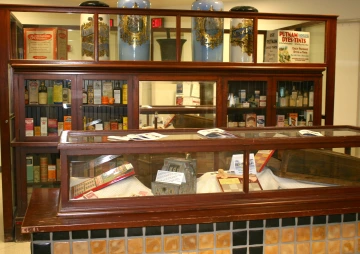MUSEUM TOUR STOP
SKAGGS BUILDING, SECOND FLOOR LOBBY

For the next tour stop, you will want to go back down the hallway and take the elevator up to the second floor. Once you arrive on the second floor, you will step off the elevator into the next exhibit space. This display features an exquisite prescription counter from the 1930s. The case came from the Ray Drug Store in Ray, Arizona. As the open pit copper mine expanded in town, many people relocated, and the owner of the pharmacy donated his counter to the College.
On the front side of the display are several over-the-counter remedies of the day. The tiles on the floor originally decorated the Winslow Drug Store. Tile work like this was commonly used as a backsplash in drugstore soda fountains. Pharmacists at the time also offered entertainment to their customers, such as punchboards and pinball and slot machines.
On the backside is the pharmacist’s work area for filling prescriptions and managing the store’s operations. Note the doctor’s prescriptions for alcohol, written during the days of Prohibition! The pharmacist’s counter holds balances, a glass tile for mixing ointments and powders, and other tools of the trade for a 1930s drug store. The drawers were usually filled with bottles and extra medication.
Just around the corner to the east is a display cabinet filled with a wide variety of mortars and pestles. Made of wood, stone, porcelain, glass, marble, clay, bronze, and iron, mortars and pestles were originally used for compounding materials but have since shifted to be mostly symbolic of the practice and history of pharmacy.

